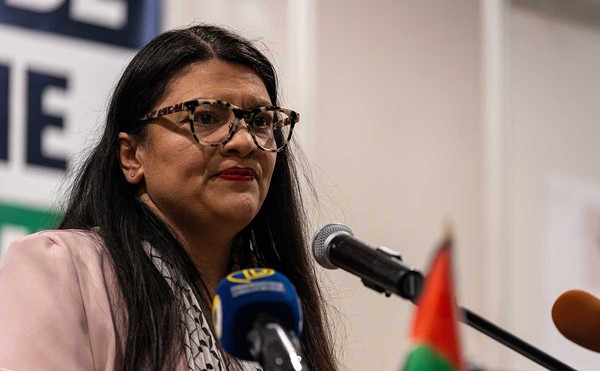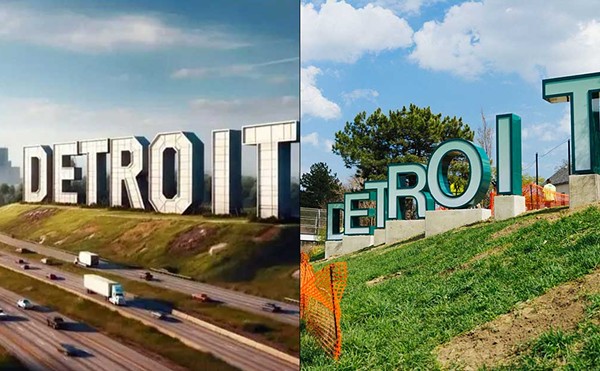Harmonie Park is this sweet little slice of Detroit. Sheltered from major thoroughfares, the downtown neighborhood's got storefronts, sidewalks and streets scaled for humans. With a pleasant park and historic buildings, it could be a haven for arts and culture. And yet over the years, restaurants, galleries, clubs and cafés have come and gone. There's been talk of pouring bucks in to create an African-American cultural district.
For now, there's a more relevant sign of life in the neighborhood: A new agitprop artist has set up shop.
The subversive art of young, hot French artist Alexis Peskine can be seen through the sheet glass windows of G.R. N'Namdi gallery, temporarily housed on Randolph Street while its permanent location in the Cultural Center undergoes a major renovation and expansion.
On a gray afternoon last week, just one and half days before Peskine's solo show Freedom Fried was set to open, drawings from the last exhibit hung on the walls and a handful of Peskine's pieces were still traveling toward Detroit. But George N'Namdi is smooth, charming and unflappable, as usual.
While dining next door on a Detroiter salad at Lola's, he explains what prompted him to present something out of the ordinary for him at his gallery. See, 'Namdi usually doesn't "do" young artists.
"This is probably our second young artist that we've had where we started from scratch, but I saw his work at a show in Brooklyn and thought it was provocative," he says. He'll be showing Peskine's photos, paintings and mixed-media installations in his Chicago and New York City galleries as well. But first, 'Namdi enticed the Parisian to Detroit.
"We need the energy here so much," he says.
It's about business: When you create energy among young art lovers, the collectors will follow.
"The gallery is changing a little bit in Detroit. I'll be doing a lot more with local and younger artists. This is a nice introduction to that. But also, being in Harmonie Park, I thought I would take other liberties with the art; I don't feel like I'm bound to the traditional things I do. I wanted to do things I may not have tried before."
Peskine is a philosopher. His visual language is so polished, so tight, so iconographic, you get the impression you've seen it somewhere before. But that subtlety deceives. He pours energy into his art with equal doses of cynicism and sensitivity to present scathing commentary on race and religion in the Western world.
As the son of a Franco-Russian father and Afro-Brazilian mother, he grew up in Paris, frustrated by the discrimination mostly targeting African and Arab youth. His pop-inspired graphics express the unrest that still exists in the aftermath of colonialism and slavery.
Over the phone, speaking from Jersey City, N.J., Peskine's accent is both hard and soft; he's a Frenchman who's learned English on the East Coast. He talks about his childhood.
"My mother boycotted half the businesses in our neighborhood because at one point or another someone would call her a name or make a comment she didn't like. My father, sometimes he didn't see it, which I understand. His father was in a concentration camp. He came from a background that encouraged him to work and to be invisible."
At 28, Peskine is anything but invisible. While he has yet to shine in the spotlight in his native country, the 2004 Fulbright scholar holds a BFA from Howard University in Washington, D.C., as well as an MA and MFA from Maryland Institute College of Art. In July 2007 The New York Times profiled him in conjunction with an exhibit at Brooklyn's Museum of Contemporary African Diasporan Arts, and his work currently hangs alongside that of Betye Saar and Gordon Parks in Martin Luther King Jr.: Life, Times and Legacy at the Wadsworth Atheneum Museum of Art in Hartford, Conn. Musicians Donald Byrd, Talib Kweli and Common collect his art, and word has it Peskine has attracted the attention of curators at both the Whitney Museum and the New Museum of Contemporary Art in New York.
After completing his undergraduate studies, Peskine worked for a while as a graphic designer. His art employs tricks of the trade and tweaks culture icons to convey his message.
"Axis of Evil" features a portrait of Jesus wearing a devilish-looking Batman mask, against a backdrop of the American flag. The savior's eyes are cut from dollar bills.
In effect, he likens Bush's rhetoric about invading Iraq to a superhero's crusade, a holy mission, implying that the administration instead has its sights set on financial gain.
"In the art world, a lot of people are reacting to Bush and his policies. I've seen many images that for me were too simple. My whole exercise is to think backwards in order to speak of this issue. How can I talk about that without being too obvious?"
Rather than twiddling his thumbs in his studio, the artist says he considers all people and places in his environment as inspiration.
"I even found inspiration in the grocery store, where I once saw a Monopoly game."
Replacing the figure of Rich Uncle Pennybags (otherwise known as Mr. Monopoly) with the Black Panther cat or Che Guevara, he suggests a world in which revolution is en vogue — a commodity to be sold: Ramdane Touhami, the son of a French Union organizer, owns the clothing line Resistance R.T. He has collaborated with current Panthers leader David Hilliard to produce T-shirts and hoodies featuring the empowerment fist. At Target you can buy Guevara posters and T-shirts.
"The whole irony between something so communist and something so capitalist is pretty interesting. It's kind of weird. I'm not criticizing it, just translating my own feelings. I can understand if you feel strongly about something, but a revolution comes with causalities. People have to die. It made me wonder, would I really want to wear that?"
A series of Peskine's work features portraits constructed from nails pounded into wood, imitating the matrix pattern of a Lichtenstein in 3-D, but retooling it with a dark side. The materials evoke everything from the crucifixion to exhausting blue-collar jobs. Congolese people pound nails into fetish statuary to communicate with the other world and ask for spiritual protection. Peskine says, for him, the process also symbolizes the transcendence of black people who have been hurt but use it to build themselves back up.
"Aunted" is a portrait of a naturally pretty young woman, a poet and critic friend of Peskine's. In the painting, Aunt Jemima, wearing a blond wig, springs from her head like Athena from the head of Zeus. He's contrasting three black female stereotypes that women today must contend with: The Afro-centric 'black is beautiful' image, the mammy character and the contemporary woman who "wants" to be white, with a blown and dyed perm. The image conveys an inner battle for identity that draws ammunition from a painful cultural memory.
"There's pressure in the corporate world to fit in," Peskine says. "And I think a lot of black people have a little white person in their head, so it refers to that too."
Some of his pieces speak more specifically to problems in Europe.
"In France, talk of race is taboo. There's not a census, or much studying of the mechanics of race," he says.
"Before 2005, it was a little frustrating. People in the rest of the world didn't know much about Paris, they only saw the romantic side of a cosmopolitan city, but so many of us are going through stuff. I think there's a misconception. Prominent African-Americans who came over to Paris felt much more freedom, but for Caribbean French people, who came from slavery or colonialism, we are treated completely differently."
Peskine refers to the incessant "identity checks," which have been cited in the media as one example of the profiling causing anger and resentment among minorities. The civil unrest that occurred in 2005 was an indirect response to the deaths of two young men in Clichy-sous-Bois, a poor area in an eastern Parisian suburb, who were reportedly hiding because they thought they were being chased by police.
His nail piece "Lessoned" pictures a grave-faced woman in Muslim garb. Astérix le Gaulois, a "loveable" warrior from a 1950s French comic book series, clings to her shoulder — naked. The image mocks, as if to say perhaps just a little wit could ease her stress. While the tiny adventurer seems to represent France's ridicule of her beliefs, he might also be a product of her own subconscious, an angel-devil whispering in her ear.
Peskine's art exists in a world where images can lead to violence. Cartoonists' renderings of the Prophet Muhammad — considered blasphemy by many Muslims — printed first in a Danish newspaper and reprinted across Europe in 2006, sparked demonstrations in Europe and then in Muslim countries; at least 50 people were reported killed.
This February police reported a plot to kill one of the cartoonists. His drawing, reprinted along with the plot reports, set off additional demonstrations in Europe and abroad. The recent publication of the drawing was cited by Osama bin Laden in his most recent call for retaliation on the European Union.
Peskine wouldn't be wrong to worry about reactions to his own work, but he points to what he believes is a critical difference:
"Fine art is open-ended. It opens up the discussion," Peskine says. There's a fine line between being intellectually confrontational and being insulting. "Those drawings were insulting, and you can't start a conversation that way. You're only going to have a fight."
He continues, "I just read Infidel by Ayaan Hirsi Ali — I had been reading about Islamophobia and I wanted the other perspective. Infidel is Ali's story about being a Somali-born Muslim woman and a member of the Dutch parliament. She did this movie with the film director, Theo Van Gogh, which was a critique of abuse against Muslim women, honor crimes, repression, a lot of things. People wanted to kill her for it; she couldn't even know where she was in order to keep her safe." (That was after Van Gogh was, in fact, assassinated.)
"I create art from what I know, as Ali did. But if you are not from a specific group, you need to have respect. You can't be arrogant to believe you have the absolute truth, and you have to be humble enough to know that."
Peskine says the bigotry in his native country has caused Arabs and Africans to unite. "In the hood, there are two sectors that young people respect, Muslims and 'big brothers,' we call them; you know, the young black people who are a little bit older. Sarkozy [now French president, then interior minister] called them bullies. There are still animosities between the groups," he says, "but there's also fraternity, because both of these people have been discriminated against."
After first coming to the United States in 1997 on a high school basketball scholarship, Peskine returned again to attend college, saying that his studies at Howard University opened up a whole new world of American artists, from Warhol to the painters of the Harlem Renaissance.
"There's this whole societal thing in France that discourages our people from expressing themselves in certain ways."
He adds, "There aren't too many black artists, and the representation of minorities is so small you could not name 10 black actors in France, whether it's because it's not encouraged or people don't want to see them on the screen."
(One of the few black performers to rise to prominence there in recent years is the comedian Dieudonné M'Bala M'Bala, who was recently profiled in The New Yorker as an outspoken anti-Semite who campaigned for president in 2006 on an anti-Zionist ticket.)
Speaking specifically about the visual arts, Peskine voices his frustration. "Not even two hours away, you can go to London and find black artists that are relevant on the international scene."
Peskine's oeuvre sometimes seems like the work of different artists. Imagine an image of TinTin as a skinhead installed next to a gritty black-and-white photo next to a glossy painting resembling a Nike ad. He gets such disparate styles to interact by mixing idioms. By incorporating elements from the world of advertising and fine art, from contemporary culture and world history, from Europe and the United States, Peskine's art crosses boundaries of class, race, even land-nationality, to speak succinctly to as many people as possible.
"I don't want to be elitist. I want to use techniques that strike you, so people in the arts will be impressed by it, but the conversation I bring up will be on a broader scale."
While he's an avid reader, his views are gleaned from that which you can't find on the page. A lot of his ideas about America are informed by the time he spent living in Baltimore, a city not unlike Detroit.
"I went to this conference this past summer, in which the director of Baltimore's Museum of Art pointed out that the institution sits right in the middle of a white hood, and you can't get those people to come in. And people on the east side have never been in the west side. They should get them in there, with cute girls to bring in the young guys, by bringing in their music ... you can't force them, but they will come. Maybe it won't have to do with the art at first."
Peskine currently resides in Jersey City and commutes in to New York City, but his work visa's running out. He returns soon to Paris, where his parents and three brothers — an R&B music producer with the stagename Gystere, as well as a designer and a visual artist-musician — still live.
Before he leaves, he'll stop for a few days here to preach to the choir that the race wars are far from over. The color of your skin, how you wear your hair, how you speak and who you worship — in Detroit, in Baltimore, in Jersey City and in Paris — matters more than ever. It's one of the few things uniting us, hammered into all our heads.
An artist reception for Freedom Fried is 6-9 p.m., Thursday, March 27. The show runs through May 3 at G.R. N'Namdi Gallery, 1435 Randolph St., Detroit; 313-831-8700.
Rebecca Mazzei is Metro Times arts and culture editor. Send comments to [email protected]




